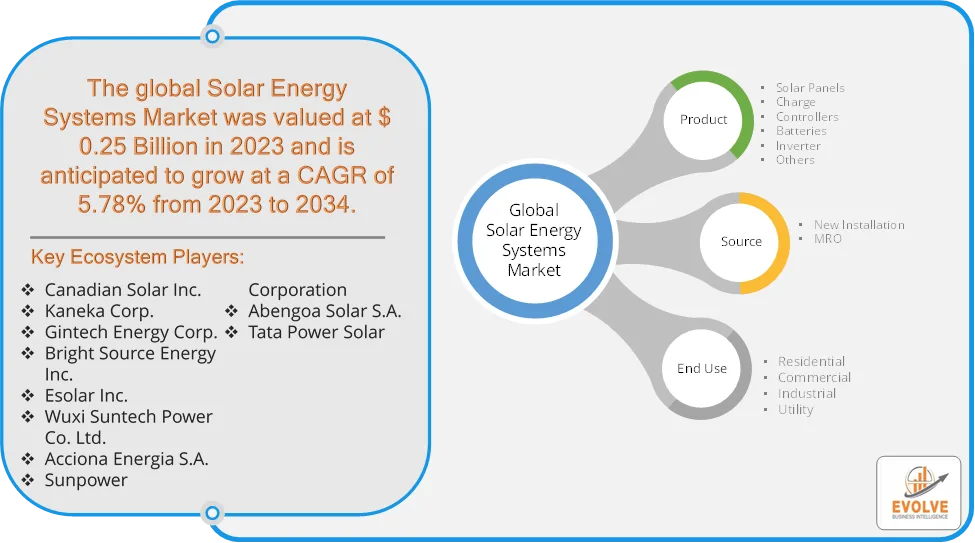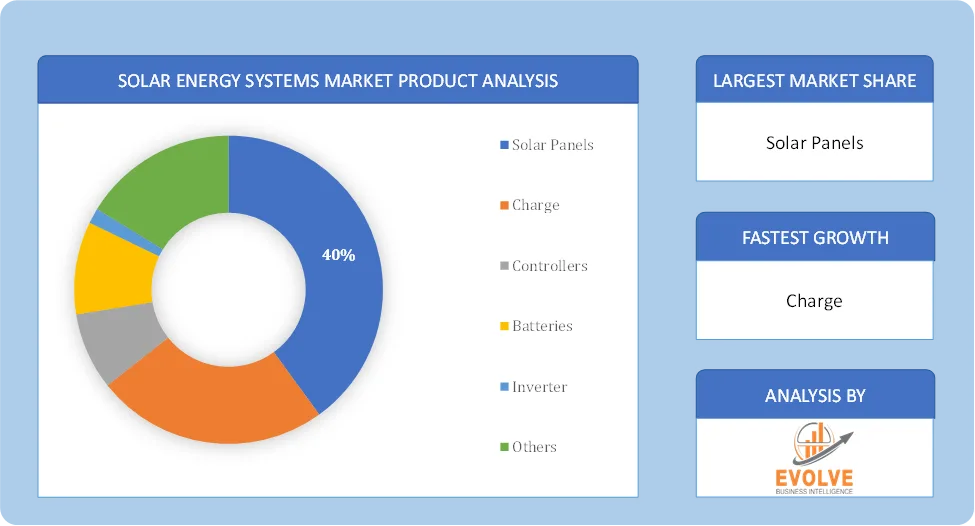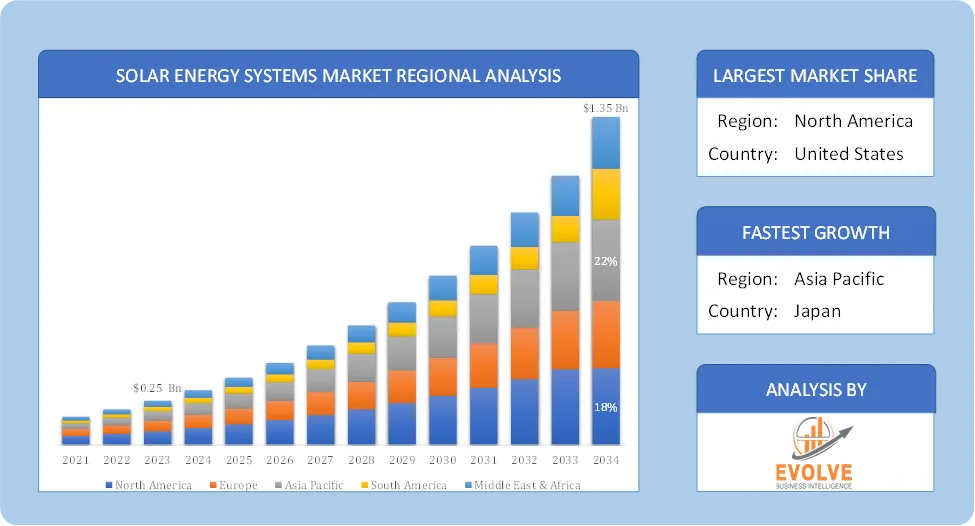Price range: $ 1,390.00 through $ 5,520.00
Solar Energy Systems Market Research Report: Information By Product (Solar Panels, Charge, Controllers, Batteries, Inverter, Others), By End Use (Residential, Commercial, Industrial, Utility), By Source (New Installation, MRO), and by Region — Forecast till 2034
Page: 165
Description
Solar Energy Systems Market Overview
The Solar Energy Systems Market size accounted for USD 0.25 Billion in 2023 and is estimated to account for 0.75 Billion in 2024. The Market is expected to reach USD 1.35 Billion by 2034 growing at a compound annual growth rate (CAGR) of 5.78% from 2024 to 2034. The Solar Energy Systems Market is experiencing significant growth due to the increasing global focus on renewable energy, government incentives, and advancements in solar technology. Solar energy systems include photovoltaic (PV) panels, solar thermal systems, and hybrid solar systems designed for residential, commercial, and industrial applications.
The solar energy systems market is projected to grow steadily, driven by increasing renewable energy adoption, improved storage solutions, and favorable government policies. The solar energy systems market is poised for continued growth, driven by technological innovation, supportive government policies, and the increasing global focus on sustainability.
Global Solar Energy Systems Market Synopsis
 Solar Energy Systems Market Dynamics
Solar Energy Systems Market Dynamics
The major factors that have impacted the growth of Solar Energy Systems Market are as follows:
Drivers:
Ø Growing Demand for Clean and Renewable Energy
Rising global awareness about climate change and carbon emissions is pushing governments and industries toward clean energy solutions. Countries are committing to net-zero carbon goals and increasing their reliance on solar power. Continuous technological advancements have reduced the cost of solar photovoltaic (PV) modules and installation. Economies of scale, improved manufacturing processes, and increased competition among solar companies are lowering prices. Increasing costs of fossil fuels and grid electricity are making solar energy a more attractive alternative and energy independence is a growing priority for businesses and households, reducing reliance on conventional power sources.
Restraint:
- High Initial Investment Costs and Intermittency & Reliability Issues
Although solar energy is becoming more affordable, the upfront cost of solar panel installation, inverters, and battery storage remains a barrier for many consumers. Commercial and industrial-scale solar projects require significant capital investment, which can deter businesses without long-term financial planning. Solar energy generation is weather-dependent, making it less reliable compared to conventional energy sources and energy production drops during cloudy days and at night, requiring efficient storage solutions or backup power from the grid.
Opportunity:
⮚ Rising Demand for Decentralized & Off-Grid Solar Solutions
Growing demand for solar microgrids and off-grid solar systems in remote and rural areas, particularly in Africa, Asia, and Latin America. Off-grid solar solutions provide electricity to regions lacking traditional grid infrastructure. AI-powered energy management systems and smart grids allow better solar energy distribution. IoT-enabled solar monitoring systems improve performance tracking and predictive maintenance. Increasing adoption of solar EV charging stations as governments promote electrification of transportation and Commercial businesses and fleet operators are integrating solar-powered EV infrastructure to reduce operational costs.
Solar Energy Systems Market Segment Overview
Based on Product, the market is segmented based on Solar Panels, Charge, Controllers, Batteries, Inverter, Others. The solar panels segment dominant the market. The most important component of a solar energy system is the solar panel, which transforms solar energy into electrical energy. Depending on the installation’s needs, multiple solar panel types, including crystalline silicon and thin film are employed.
By Source
Based on Source, the market segment has been divided into New Installation, MRO. The new installation segment dominant the market. The adoption of solar energy technology is underway, and several nations are encouraging the installation of solar energy systems for the production of electricity. Utility-scale solar systems are being funded by several nations to lower national carbon emissions, which is predicted to boost product demand. Thereby, driving the segment expansion over the forecast period.
By End Use
Based on End user, the market segment has been divided into Residential, Commercial, Industrial, Utility. The utility segment dominant the market. utility-scale solar has produced reliable, clean energy with a steady fuel price. It is also considered one of the quickest methods to minimize carbon emissions is to develop utility-scale solar electricity. Moreover, utilities invest in research and development to improve the efficiency, reliability, and cost-effectiveness of solar energy technologies.
Global Solar Energy Systems Market Regional Analysis
Based on region, the global Solar Energy Systems Market has been divided into North America, Europe, Asia-Pacific, the Middle East & Africa, and Latin America. North America is projected to dominate the use of the Solar Energy Systems Market followed by the Asia-Pacific and Europe regions.
North America holds a dominant position in the Solar Energy Systems Market. It has strong government incentives and policies, particularly in the United States, Increasing corporate sustainability initiatives, growing demand for residential solar installations. It Increasing adoption of solar-plus-storage solutions and focus on grid modernization to integrate renewable energy. The U.S. market is driven by both federal and state-level policies.
Asia-Pacific Market
The Asia-Pacific region has indeed emerged as the fastest-growing market for the Solar Energy Systems Market industry. It’s driven by countries like China, India, and Japan. Aggressive renewable energy targets and substantial investments in solar infrastructure are key factors. China’s manufacturing capabilities and large-scale project deployments give it a significant edge and India’s focus on rooftop solar and its ambitious renewable energy goals are driving substantial growth.
Competitive Landscape
The global Solar Energy Systems Market is highly competitive, with numerous players offering a wide range of software solutions. The competitive landscape is characterized by the presence of established companies, as well as emerging startups and niche players. To increase their market position and attract a wide consumer base, the businesses are employing various strategies, such as product launches, and strategic alliances.
Prominent Players:
- Canadian Solar Inc.
- Kaneka Corp.
- Gintech Energy Corp.
- Bright Source Energy Inc.
- Esolar Inc.
- Wuxi Suntech Power Co. Ltd.
- Acciona Energia S.A.
- Sunpower Corporation
- Abengoa Solar S.A.
- Tata Power Solar.
Key Development
In December 2023, Geneverse, a US-based developer of revolutionary home solar power solutions, made its European premiere at the highly anticipated Smarter E Europe 2023 expo, which was hosted in conjunction with The Smarter E Show. The Smarter E is a prestigious worldwide conference that brings together industry professionals, inventors, and enthusiasts to discuss the most recent trends and achievements in renewable energy.
Scope of the Report
Global Solar Energy Systems Market, by Product
- Solar Panels
- Charge
- Controllers
- Batteries
- Inverter
- Others
Global Solar Energy Systems Market, by Source
- New Installation
- MRO
Global Solar Energy Systems Market, by End Use
- Residential
- Commercial
- Industrial
- Utility
Global Solar Energy Systems Market, by Region
- North America
- US
- Canada
- Mexico
- Europe
- UK
- Germany
- France
- Italy
- Spain
- Benelux
- Nordic
- Rest of Europe
- Asia Pacific
- China
- Japan
- South Korea
- Indonesia
- Austalia
- Malaysia
- India
- Rest of Asia Pacific
- South America
- Brazil
- Argentina
- Rest of South America
- Middle East & Africa
- Saudi Arabia
- UAE
- Egypt
- South Africa
- Rest of Middle East & Africa
| Parameters | Indicators |
|---|---|
| Market Size | 2034: USD 1.35 Billion |
| CAGR (2024-2034) | 5.78% |
| Base year | 2022 |
| Forecast Period | 2024-2034 |
| Historical Data | 2021 (2017 to 2020 On Demand) |
| Report Coverage | Revenue Forecast, Competitive Landscape, Growth Factors, and Trends |
| Key Segmentations | Product, Source, End use |
| Geographies Covered | North America, Europe, Asia-Pacific, South America, Middle East, Africa |
| Key Vendors | Canadian Solar Inc., Kaneka Corp., Gintech Energy Corp., Bright Source Energy Inc., Esolar Inc., Wuxi Suntech Power Co. Ltd., Acciona Energia S.A., Sunpower Corporation, Abengoa Solar S.A. and Tata Power Solar. |
| Key Market Opportunities | · Rising Demand for Decentralized & Off-Grid Solar Solutions
· Integration with Smart Grids & IoT |
| Key Market Drivers | · Growing Demand for Clean and Renewable Energy
· Declining Costs of Solar Panels & Installation |
REPORT CONTENT BRIEF:
- High-level analysis of the current and future Solar Energy Systems Market trends and opportunities
- Detailed analysis of current market drivers, restraining factors, and opportunities in the future
- Solar Energy Systems Market historical market size for the year 2021, and forecast from 2023 to 2033
- Solar Energy Systems Market share analysis at each product level
- Competitor analysis with detailed insight into its product segment, Government & Defense strength, and strategies adopted.
- Identifies key strategies adopted including product launches and developments, mergers and acquisitions, joint ventures, collaborations, and partnerships as well as funding taken and investment done, among others.
- To identify and understand the various factors involved in the global Solar Energy Systems Market affected by the pandemic
- To provide a detailed insight into the major companies operating in the market. The profiling will include the Government & Defense health of the company’s past 2-3 years with segmental and regional revenue breakup, product offering, recent developments, SWOT analysis, and key strategies.
Frequently Asked Questions (FAQ)
What is the growth rate of the global Solar Energy Systems Market?
The global Solar Energy Systems Market is growing at a CAGR of 5.78% over the next 10 years
Which region has the highest growth rate in the market of Solar Energy Systems Market?
Asia Pacific is expected to register the highest CAGR during 2024-2034
Which region has the largest share of the global Solar Energy Systems Market?
North America holds the largest share in 2022
Who are the key players in the global Solar Energy Systems Market?
Canadian Solar Inc., Kaneka Corp., Gintech Energy Corp., Bright Source Energy Inc., Esolar Inc., Wuxi Suntech Power Co. Ltd., Acciona Energia S.A., Sunpower Corporation, Abengoa Solar S.A. and Tata Power Solar. are the major companies operating in the market.
Do you offer Post Sale Support?
Yes, we offer 16 hours of analyst support to solve the queries
Do you sell particular sections of a report?
Yes, we provide regional as well as country-level reports. Other than this we also provide a sectional report. Please get in contact with our sales representatives.
Additional information
| Packages | Single User License, Enterprise License, Data Pack Excel |
|---|



